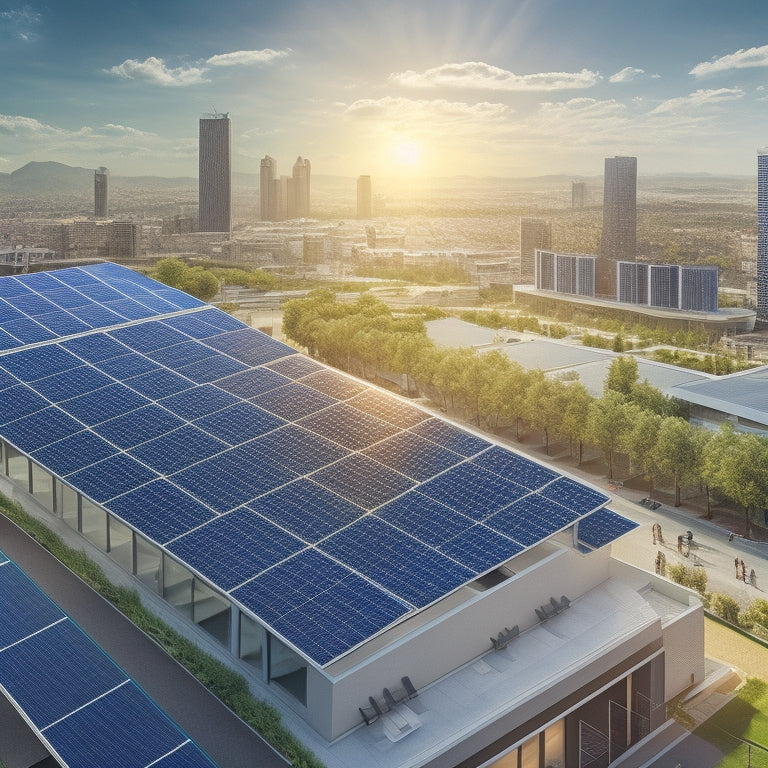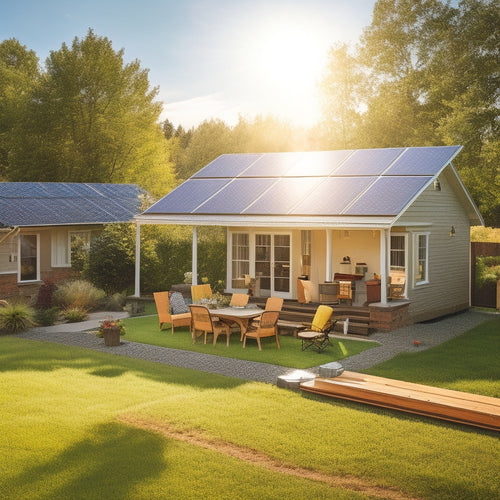
Implementing Solar in Commercial Buildings in 10 Steps
Share
You're considering implementing solar energy in your commercial building, a smart move given that solar-powered buildings can reduce energy costs by up to 50%. To get started, you'll need to assess your building's energy consumption, evaluating its usage patterns and identifying opportunities for efficiency improvements. Next, evaluate your roof's condition and size to determine its feasibility for solar installation. From there, you'll need to determine the best solar panel installation type, secure necessary permits and approvals, and choose a qualified installer. By following these initial steps, you'll be well on your way to utilizing the power of solar energy - and there's more to investigate in the process.
Key Takeaways
- Assess building energy consumption patterns over 12-24 months to identify trends and efficiency opportunities for effective solar panel system sizing.
- Evaluate the roof condition, size, and orientation to ensure structural integrity and sufficient space for optimal solar panel placement.
- Determine the suitable solar panel installation type, such as ballasted or attached systems, based on roof size, orientation, and structural integrity.
- Secure necessary permits and approvals from local government and utility companies to ensure compliance with regulations and interconnection standards.
- Choose a qualified solar installer with relevant certifications, experience, and training to ensure a safe and efficient installation process.
Assess Building Energy Consumption
As you prepare to integrate solar power into your commercial building, evaluating its current energy consumption is an important first step. This assessment will help you understand your building's energy usage patterns, identify areas of inefficiency, and determine the best size of your solar panel system.
Conducting an energy audit is a vital part of this process. This involves analyzing your building's energy consumption patterns, including the amount of energy used, when it's used, and how it's used.
You'll need to gather data on your energy usage over a period of time, typically 12-24 months, to identify trends and patterns. This data will help you pinpoint opportunities to reduce energy consumption and enhance your building's energy efficiency.
Evaluate Roof Condition and Size
You'll need to assess the roof's condition and size to determine its suitability for solar installation.
Start by reviewing the roof's age and history, as well as any previous repairs or replacements, to identify potential issues.
Next, you'll need to evaluate the structural integrity of the roof and measure the available space to guarantee it can support the weight and size of the solar panels.
Roof Age and History
About 70% of commercial roofs are past their warranty expiration date, which means they may be nearing the end of their useful life. As you evaluate your roof's condition and size for solar implementation, it's crucial to take into account its age and history.
You'll want to assess the roof's maintenance history, including any historical repairs, to determine if it's a suitable candidate for solar installation.
Review the roof's maintenance records to identify any recurring issues or areas that have required frequent repairs. This will help you understand the roof's overall condition and potential weaknesses.
You should also inspect the roof visually, looking for signs of wear, such as cracks, blisters, or damaged flashing.
Documenting the roof's age, material, and repair history will help you determine the best approach for solar installation. This information will also be useful in developing a plan for roof maintenance and repairs that may be required before or during the solar installation process.
Assess Structural Integrity
The roof's structural integrity is a critical factor in determining its suitability for solar installation. You need to evaluate the roof's condition and size to confirm it can support the weight of the solar panels and withstand various environmental factors.
To analyze the roof's structural integrity, you'll need to conduct structural assessments and load calculations. These evaluations will help you determine if the roof can support the additional weight of the solar panels, including the weight of the panels themselves, the mounting system, and any potential snow or wind loads.
Some key considerations for evaluating structural integrity include:
-
Roof material and age: Is the roof made of durable materials, and is it within its expected lifespan?
-
Roof pitch and angle: Is the roof pitched at an angle that allows for efficient water runoff and snow shedding?
-
Roof obstructions: Are there any obstructions, such as skylights or vents, that could interfere with the solar installation?
- Local building codes and regulations: Does the roof meet or exceed local building codes and regulations for structural integrity?
Available Roof Space
As you move forward with your solar installation, evaluating the available roof space is essential to determining the ideal system size and layout. This assessment involves examining the roof's condition, size, and orientation to guarantee the solar panels can operate at maximum efficiency.
You'll need to inspect the roof for any obstructions, such as skylights, vents, or HVAC units, which could impact the placement of solar panels. Additionally, consider the roof's age, material, and overall condition to guarantee it can support the weight of the solar panels.
Conduct a shading analysis to identify any areas that may receive partial or full shade throughout the day, which could affect energy production.
You should also examine the roof's orientation, as south-facing roofs typically receive the most direct sunlight and are ideal for solar installations.
Determine Solar Panel Installation Type
How much roof space can you dedicate to solar panels? This determines the type of solar panel installation you can implement.
You'll need to evaluate factors like roof size, orientation, and structural integrity to decide which installation method is best for your commercial building.
You have several solar panel types and installation methods to choose from:
-
Ballasted systems: These non-penetrating systems use weights to secure the solar panels to the roof, ideal for roofs with weight restrictions.
-
Attached systems: These systems attach directly to the roof, providing a more secure and durable installation.
-
Tracker systems: These systems allow solar panels to move with the sun, increasing energy production, but requiring more space and maintenance.
- Building-integrated photovoltaics (BIPV): These systems integrate solar panels into the building's design, providing both energy generation and building envelope functionality.
Choose an installation method that suits your building's unique characteristics and energy goals.
Evaluate factors like energy output, cost, and maintenance requirements to make an informed decision.
Secure Necessary Permits and Approvals
You've determined the ideal solar panel installation type for your commercial building, now it's time to obtain the necessary permits and approvals before moving forward with the project. This step is essential to guarantee regulatory compliance and avoid costly delays.
Begin by submitting a permit application to your local government, which will review your project plans to confirm they meet zoning regulations and local ordinances. You may also need to conduct environmental assessments to identify potential hazards and take measures to mitigate them.
Additionally, you'll need to obtain approval from your utility company for the utility interconnection, which will enable you to feed excess energy back into the grid. Verify that your project meets public safety standards and complies with all relevant building codes.
Choose a Qualified Solar Installer
When selecting a solar installer for your commercial building, you'll want to evaluate their qualifications and experience to guarantee a successful project.
A qualified installer will have the necessary certifications, licenses, and training to design and install a system that meets your energy needs and local building codes.
Solar Installer Qualifications
Selecting a qualified solar installer is essential to guaranteeing a successful commercial solar project. You want to make certain that your solar installer has the necessary skills, knowledge, and experience to design and install a high-quality solar system that meets your energy needs and complies with industry standards.
When evaluating a solar installer's qualifications, look for the following:
-
Certification programs: Check if the installer is certified by reputable organizations such as the North American Board of Certified Energy Practitioners (NABCEP) or the International Association of Electrical Inspectors (IAEI).
-
Industry standards: Verify the installer follows industry standards and best practices, such as those set by the National Electric Code (NEC) and the International Electrotechnical Commission (IEC).
-
Training requirements: Confirm that the installer meets the necessary training requirements, including OSHA certification and equipment-specific training.
- Compliance with local regulations: Ensure that the installer is familiar with local building codes, permits, and regulations.
Installer Experience Matters
A qualified solar installer's certification and adherence to industry standards are only the foundation of a successful commercial solar project.
You'll want to dig deeper to ascertain the installer has the experience to handle your project's unique needs. Check their reputation by reading reviews, asking for referrals, and verifying their ratings with organizations like the Better Business Bureau.
A seasoned installer will have a proven track record of completing projects on time and within budget. They'll also have the knowledge to maneuver through intricate permitting and inspection processes, minimizing delays in your project timeline.
When evaluating an installer's experience, ask about their history with commercial projects similar to yours. How many projects have they completed? What were the sizes and intricacies of those projects? What were the results?
Design a Custom Solar Array System
To maximize energy production and minimize installation costs, you'll need to design a custom solar array system that takes into account your commercial building's unique characteristics, such as its size, shape, and orientation.
A well-designed solar array system guarantees energy efficiency and peak performance. Consider the following factors to get the most out of your solar investment:
-
Assess building load and energy usage: Analyze your building's energy consumption patterns to determine the required solar array size and configuration.
-
Evaluate roof size and condition: Assess the roof's structural integrity, size, and orientation to determine the best solar panel layout and quantity.
-
Identify shading obstacles: Take into account nearby obstructions, such as trees, buildings, or skylights, that may impact energy production.
- Optimize system configuration: Balance energy production and cost by selecting the right solar panel type, inverter, and mounting system for your building's specific needs.
Install Solar Panels and Equipment
With a custom solar array system designed, you're now ready to bring it to life by installing the solar panels and equipment. This step involves physically placing the solar panels on your commercial building's roof or in a ground-mounted system.
You'll need to choose the right solar panel types for your system, considering factors like efficiency, durability, and cost. Make certain the panels are securely fastened to the roof or mounting system to withstand various weather conditions.
The equipment required includes inverters, which convert DC power to AC power, and mounting hardware. Install the inverters in a well-ventilated area, away from moisture and extreme temperatures. It's essential to follow the manufacturer's instructions for equipment installation and wiring.
Proper equipment maintenance is imperative to guarantee the system's longevity and peak performance. Schedule regular inspections and maintenance tasks, such as cleaning the panels and checking for loose connections.
Connect to the Grid and Monitor
Frequently, the final step in implementing a solar array system is often overlooked, yet it's crucial in guaranteeing the system's success: connecting to the grid and monitoring its performance.
You must verify that your solar array is properly connected to the grid to sell excess energy back to the utility company and offset your energy consumption. A grid connection also allows you to monitor your system's performance in real-time.
To secure a successful grid connection and monitoring, you should:
- Confirm your system meets the utility company's interconnection requirements
- Install a bi-directional meter to track energy production and consumption
- Implement a monitoring system to track performance and identify potential issues
- Set up remote monitoring and alerts to receive notifications of system downtime or underperformance
Claim Incentives and Rebates Available
You'll want to investigate the various incentives available to offset the cost of your commercial solar installation.
The federal government offers tax credits that can greatly reduce your tax liability, and you may also be eligible for state and local incentives that can further reduce your upfront costs.
Federal Tax Credits
By investing in solar energy, commercial building owners and developers can tap into a lucrative incentive: federal tax credits.
These credits can greatly reduce your tax liability, providing a considerable return on investment. As a commercial building owner or developer, you can claim federal incentives for your solar installation, resulting in considerable tax savings.
Here are some key benefits of federal tax credits:
-
30% of total solar installation costs: You can claim 30% of the total cost of your solar installation as a tax credit, providing a noteworthy reduction in your tax liability.
-
Five-year depreciation: You can depreciate your solar installation over five years, allowing you to claim additional tax savings.
-
No cap on credits: There's no cap on the amount of federal tax credits you can claim, making this incentive particularly beneficial for large-scale solar installations.
- Carryover provision: If you can't use all your tax credits in a single year, you can carry them over for up to 20 years, ensuring you maximize your tax savings.
State and Local Incentives
In addition to federal tax credits, you can also tap into state and local incentives to further reduce the cost of your solar installation. These incentives can greatly impact your project's financials, and it's crucial to research and understand the opportunities available in your area.
State incentives can include rebates, tax credits, or grants that can be applied directly to your project costs. For example, some states offer rebates based on the system size or installation cost. You can check the Database of State Incentives for Renewables & Efficiency (DSIRE) to find out what's available in your state.
Local programs can also provide additional benefits, such as property tax exemptions, sales tax exemptions, or even special financing options. Municipalities or counties may offer these incentives to encourage sustainable development and reduce carbon emissions.
Be sure to check with your local government to see what's available. By combining state and local incentives with federal tax credits, you can maximize your savings and accelerate your project's return on investment.
Monitor and Maintain the System
Your commercial solar system's performance is only as good as its maintenance, and regular monitoring guarantees that any issues are caught and addressed promptly.
To guarantee peak system performance, you'll need to establish a maintenance schedule that includes regular inspections, cleaning, and troubleshooting.
Here are some key considerations for monitoring and maintaining your commercial solar system:
-
Utilize monitoring technology to track system performance and identify potential issues before they impact energy production. This data analysis will help you enhance efficiency and identify opportunities for improvement.
-
Develop a preventive maintenance schedule to guarantee that your system is running at its best. This includes regular cleaning, inspections, and replacement of worn or damaged components.
-
Stay on top of weather impact by monitoring weather patterns and adjusting your system's performance accordingly. This will help you maximize energy production during peak periods.
- Keep troubleshooting tips on hand to quickly address any issues that arise. This will minimize downtime and guarantee that your system is producing energy efficiently.
Frequently Asked Questions
Can I Install Solar Panels on a Leased Commercial Building?
You'll need to review your lease agreement to determine if you can install solar panels on a leased commercial building, ensuring you obtain necessary tenant permissions and complying with any stipulations or restrictions outlined in the agreement.
Are There Any Tax Implications for Commercial Solar Installations?
When you're on a roll with solar, don't let taxes rain on your parade. You'll find tax incentives, like the Solar Investment Tax Credit, can considerably offset installation costs, and financing options, such as Property Assessed Clean Energy (PACE) loans, can help you utilize the sun's power.
Can I Use Solar Power for Electric Vehicle Charging Stations?
You can definitely use solar power for electric vehicle charging stations, leveraging solar charging to fuel your fleet with renewable energy; this setup not only reduces emissions but also provides a sustainable, cost-effective solution for your business.
Do Solar Panels Void My Roof's Warranty?
You're probably worried that solar panels will instantly void your roof's warranty, but fear not! In reality, most roof warranties remain intact after solar panel installation, as long as the installation is done properly and meets roofing industry standards.
Can I Expand My Solar Array System in the Future?
You'll want to guarantee your initial solar array installation considers future capacity, as a scalable system design allows you to easily add panels, increasing energy output, and accommodating your growing power needs without requiring a complete overhaul.
Conclusion
You've successfully implemented solar in your commercial building, but don't think you're off the hook that easily. One common concern is that solar panels will void your roof's warranty. Not necessarily - many manufacturers offer warranties that work in tandem with solar installations. By following these 10 steps, you've not only reduced your energy bills but also increased your building's value. Now, monitor and maintain your system to guarantee it's running at peak levels and enjoy the long-term benefits of going solar.
Related Posts
-

Steps to Prepare for Solar Installation
To prepare for solar installation, start by evaluating your current energy consumption and future needs to determine ...
-

Innovative Sustainable Materials for Energy-Efficient Homes
Innovative sustainable materials enable you to create energy-efficient homes while promoting environmental responsibi...
-

Energy-Efficient Home Upgrades for Cost Reduction
To reduce costs with energy-efficient home upgrades, focus on essential improvements like smart thermostats, energy-e...


